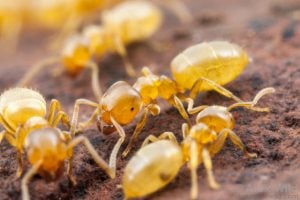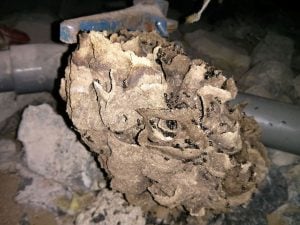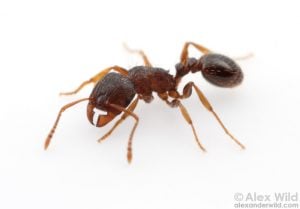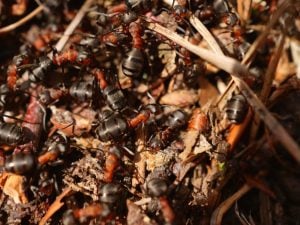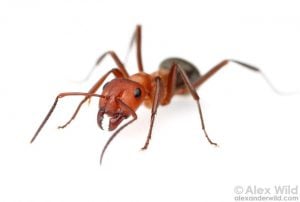Species of Ant Found in the UK
Here I describe some of the more common species of ant found in Britain. There is also a downloadable identification guide to most of the species of ant found in the UK
There are over fifty species of ant found in the UK, most of which are found in the south. The most common species of ant found in Britain is Lasius niger, the common black garden ant. Below I have described 9 of perhaps the most commonly seen species. I list all known species of ant found in the UK.
Species of ant found in the UK
Lasius niger
Perhaps the best-known species of ant to the people of England is Lasius niger, the common black garden ant. The ant is known by gardeners and household owners due to its tendency to enter houses. This ant nests under pavements, in soil and along the edges of lawns. In fact almost anywhere.
It is a very quick, robust and prolific ant, using formic acid and its jaws as a means of attack/defence. Its colonies can grow up to a size of 15,000 workers, though about 4000 to 7000 is perhaps the average.
The ants of this species eat insects, nectar, and even the bodies of their own dead, or ants from other colonies. Lasius niger are also very fond of sugary substances. Their diet consists of a variety of insects including flies, beetles, the larvae of various flies and beetles, fruit and honeydew.
These ants are easiest of all British ants to keep in captivity due to the fact that they are harmless and possess no sting. I keep a colony of Lasius niger, and I find them to be a very interesting and active ant to keep and study.
Lasius flavus
Another common ant found in gardens is Lasius flavus, the yellow meadow ant. These ants build small mounds in our lawns and are often mistaken for red ants due to their yellow-orange colour. However they are no more harmful than their common black cousins, Lasius niger.
This species is the most skilled nest builder found in the UK. Lasius flavus live in fields and meadows where they build much larger mounds. The ants forage below ground almost exclusively, and therefore are not often seen except perhaps when its nest is disturbed, or during the annual mating flights.
Their diet is similar to Lasius niger but they tend to forage below ground and therefore probably stumble across more soft–bodied larvae.
These ants look similar, almost identical in fact, when compared to Lasius umbratus, with the naked eye.
Lasius umbratus
An unusual ant very similar to Lasius flavus in appearance and nest building. Lasius umbratus do not start their colonies off in the usual manner. The newly mated umbratus queen seeks out a Lasius niger colony, and then lie in wait some distance away. A Lasius niger worker passes by, and the queen grabs it. The queen drags it into a hiding place. She uses the dead ant to obtain its colony scent.
Once done, the queen ant approaches the colony of the niger ant she just killed and will cautiously enter the nest without making any sudden or aggressive moves. You can sometimes see a large brown queen ant carrying a dead black ant in its jaws, following the annual mating flight. Chances are, this is an umbratus queen preparing for her plan of domination.
As the queen enters the nest, she will gently touch the niger workers with her antennae. If all goes well for her she will attempt to take up residence within. Once she is established the Lasius niger workers turn on their own queen and kill her. Perhaps the umbratus queen gives of a pheromone that encourages the niger workers to do this. The umbratus queen becomes the new queen, and the niger workers take care of her and her brood, as if they were their own.
This results in a colony containing both black and yellow ants. Eventually, however, the niger workers will die off, and, as there is no niger queen to replace them, the nest slow becomes made up of umbratus workers in its entirety.
I keep a colony of this species which I received as a single umbratus queen with 30 niger workers.
More species of ant found in the UK
Lasius fuliginosus
These ants are larger and faster than Lasius niger, having slender jet-black, shiny bodies with a heart-shaped head. They tend to live in carton nests made from chewing up dead wood and mixing it with honeydew, like the way wasps build their nests. The resultant paste then is applied to the nesting area, usually an old log, which then hardens into a tough structure.
I find it interesting to note that, like the Lasius umbratus queens, the Lasius fuliginosus queen cannot start her own colonies, and therefore will do so by invading the nests of Lasius umbratus. Therefore, a colony that was once a Lasius niger can, via Lasius umbratus, become a Lasius fuliginosus colony. I remember seeing a mixed colony of Lasius umbratus and fuligninosus when I was a child. I was fascinated by what I saw.
Neither Lasius niger nor umbratus make carton nests as fuliginosus do, so once the fuliginosus colony has taken over their host’s nest and become established they will look for a suitable new nesting site. Again, insects make a large part of their diet.
Myrmica sp.
There are seven species of the Myrmica family found in the UK. These ants tend to be a deep red in colour and can deliver a mildly irritant sting.
The most common of the seven species is Myrmica ruginodis which can be found throughout Britain, and lives in small colonies with between 100-300 members, but can have many egg laying queens in one colony.
I find it interesting to note that there are two sub-species of Myrmica ruginodis; one that has queens which are visibly larger than the workers, and the other has queens which are almost the same size as the worker.
Myrmica rubra is polygynous with larger than worker queens. They are aggressive and seem to be happier attacking than running away. Again, another insect feeder but also fond of spiders.
Species of ant found in the UK - continued
Tetramorium caespitum
This ant is a small black stinging ant which reminds me of a cross between Lasius niger and Myrmica rubra, though are in the same genus as the latter. They are typically found along the coasts of Southern and Western England. Tetramorium have nests containing up to 30,000 ants, but the average is perhaps 10,000.
They eat insects but an interesting feature of this ant is that they appear to bury their food in mounds of soil; I witnessed this in a Tetramorium impurum colony I used to keep.
Formica rufa
Another common British ant are those belonging to the species Formica, also known as the wood ant. Many of these species build huge mounds from pine needles and other woodland litter on the edge of forest clearings or pathways and can number more than 100,000 members per colony.
These ants are large, aggressive and attack by biting and spraying formic acid very effectively if disturbed. They are found in Southern England as well as other European countries. In some countries they are known as the Horse Ant.
They eat a wide variety of insects and insect larvae, and a large colony of these ants can bring in up to 100,000 insects per day for food!
I have been bitten by this species of ant more than any other kind. I would love to have a colony of these ants, but I have no room. to keep them. These ants need a lot of space – and food!
Formica fusca
Another wood ant species; this one black, and very much more timid than its red cousins.
Formic fusca prefer to nest under rotting logs and are found from the Midlands down to Southern England. They have populations of usually less than 1000, and though can be polygynous, they do not normally have very many queens in each colony.
These ants have extremely good eyesight but tend to be very timid, running rather than fighting. Again, insects make a large part of their diet. I kept a colony of this species a few years ago. I noticed that when I entered the room in which this colony was kept, the ants were freeze, and then they would bolt.
Formica sanguinea
These are the largest of the native British Ants and are like Formica fusca but have a deeper red colour about them.
Formica sanguinea are slave-makers and will raid the colonies of Formica fusca, stealing their brood to take back to their nest, not to eat, but to raise into adulthood. These fusca adults then become slaves to the sanguinea colony.
The sanguinea queen cannot start a new colony on her own and so will find and force her way into a Formica fusca nest, creating herself a little burrow within that colony. She then lays her own eggs defending them vigorously from the host workers.
Once her own workers hatch, they will seek out and kill the host queen, though the sanguinea queen may kill her herself. Once the fusca queen is dead then remainder of the fusca colony accept her as their new queen.
The habit of raiding further colonies of Formica fusca to provide slaves is not essential for survival as the sanguinea, once they have established a nest inside that of a fusca colony, can live perfectly well as a sanguinea colony without the need for slaves.
Lists of Species of Ant Found in the UK, Europe and the World
Download a guide to identifying species of British and European ant in spreadsheet format
Click on the button below to be taken to an external site (Wikipedia), listing all known species of ant found in the UK. The information contained therein is taken from Skinner and Allen’s Naturalists’ Handbook No. 24, published in 1996.
What about species of ants in the world? Is there a list?
This would be a huge list of some 13,000 entries. However, click on the button below to see a list of known families of ants throughout the world. You’ll get an idea of just how vast the number of species is. The button will take you to an external site, (Wikipedia).
Many of the images that I use on this page, and indeed throughout the website, were taken by Alex Wild. Alex is kind enough to allow people to use his pictures for their own websites, so long as the image is credited and attributed to him. All images belonging to Alex Wild used on this website have, therefore, been attributed to him. I am very grateful to him.
Ask questions about ants
If you wish to ask me a question about ants (and no, I won’t tell you how to destroy them or their nests!) then please contact me on my**@********co.uk or you can ask on the contact thread
I aim to respond to your questions as quickly as I can, normally within 24 hours.

